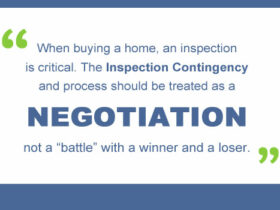 The walkthrough is the last step before buyers sign the paperwork to take ownership of a home. As such, it is the seller’s last chance to confirm that the house is ready according to the purchase contract. Follow these tips to make sure all necessary and agreed-upon tasks have been performed prior to the keys changing hands.
The walkthrough is the last step before buyers sign the paperwork to take ownership of a home. As such, it is the seller’s last chance to confirm that the house is ready according to the purchase contract. Follow these tips to make sure all necessary and agreed-upon tasks have been performed prior to the keys changing hands.
For informational purposes only. Always consult with a licensed real estate professional before proceeding with any real estate transaction.
Set Aside Time
Even under the best circumstances, your plans may not go perfectly according to schedule. Perhaps the moving truck arrives late and you have to sit and wait for several hours when you could be working on some other job. Make sure that everything brought up on the home inspection is complete. Be sure to give yourself the maximum amount of time you think you will need for each item on your checklist. Packing could take a few weeks, and moving and cleaning may need at least a few days each. Provide a little extra padding in your schedule for unplanned issues. If professional services are needed,, be sure to schedule them early enough that the business is available at an ideal time.
Put Tasks in Order
The last thing you want to happen is for the buyer to walk in and see that certain tasks are incomplete. The order in which you put your obligations should be set to give you adequate time to deal with unexpected problems.
For example, moving every item out of the home often reveals some obvious concerns, including insect or rodent infestations or structural damage somehow not brought up during the inspection. It is also possible that the home sustained some damage during the selling process. If you start with a thorough inspection of the property before you begin preparing for transfer, you can identify these issues and others.
Moving
The act of moving could take only several hours if you are fully packed and ready for the movers to remove all the boxes and furniture. Start packing with a list of items that you will place in a mover’s truck, as well as a list of delicate or important boxes that must be transferred by you personally.
Remove those things from the home before the movers arrive, so that there is no confusion about who is taking which boxes from the home. Label everything clearly so that unpacking is much less of a hassle. Schedule moving day at a date and time that is minimally stressful, to avoid the risk of damage or injury.
Clearing Out
Moving your stuff tends to bring up a host of items that you decide are not worth bringing to the new home. Homeowners may be reticent to clear all the old gardening gear out of the shed, but it really needs to go. Buyers do not want any relics of the previous owner in the home when they can be eliminated so easily.
Within a day or two of the movers’ arrival, schedule a charity or waste pickup company to take away all the excess clutter and unwanted belongings that you do not want to keep or transfer to the new house. The end goal is a perfectly clear slate for cleaning.
Final Cleaning
An entirely empty home is far simpler to clean. It is also quite a bit easier to spot problems. Sometimes, removing furniture or decorations shows faded carpets or walls. If you painted the home or replaced the flooring before you listed the property, this may not be an issue for you.
In any case, you should plan to have as thorough a cleaning for the home as you arranged before you sold it. Hire professional carpet cleaners for one last service on the flooring. Consider hiring a professional cleaning service for the rest of the home, especially the windows, bathrooms and kitchen. Make sure the place is completely spotless for the final walk-through.
Last Check for Damage
In some cases, the moving, removal and cleaning processes can cause damage to the home that was not previously there. Transporting furniture could tear off a piece of a doorjamb or even damage the door itself. Heavy moving equipment may scratch hardwood flooring. Abrasive cleansers can etch certain types of surfaces.
Confirm that there is enough time on the schedule for a hasty repair, and keep the contact information on hand for an electrician or plumber. A little forward thinking can avoid an embarrassing conversation when the buyers arrive to see if the home is move-in ready.
Common Walk-Through Issues
When home buyers perform the final walk-through, they’ll be on the lookout for many things. Ideally, the home will be clean and in good repair when the walk-through takes place. Below are common problems that can affect the home sale.
Home Is Dirty
Visible dirt or mud on the floor that was not there when the home buyers made the offer could cause problems. While some dust or scuff marks may be acceptable, the carpeting and floors should not be unreasonably dirty.
Home is Not Empty
No home buyer wants to deal with a seller’s discarded stuff. Unless some furnishings or personal items were sold to the buyer with the home, the house should be completely empty for the final walk-through.
Home is Damaged
Damage that was done to the home either during the move or sometime after the buyer entered the escrow period must be repaired before the sale can be final. Likewise, any repairs that were written into the home sale contract should also be completed for the walkthrough.
Start Preparing For Your Final Walkthrough Now
The last thing any home seller wants is a lot of problems that come up just as they are ready to exchange keys. If you give yourself adequate time for each part of your to-do list, you will have the flexibility to take care of issues as they arise and guarantee a better result for the conclusion of your home sale.
For informational purposes only. Always consult with a licensed real estate professional before proceeding with any real estate transaction.



